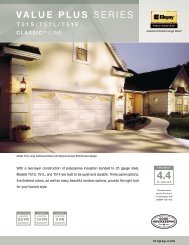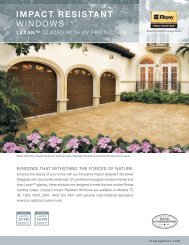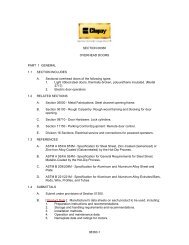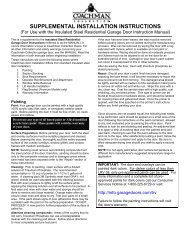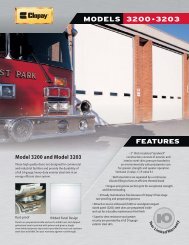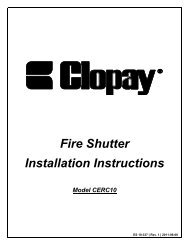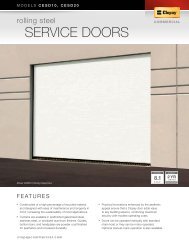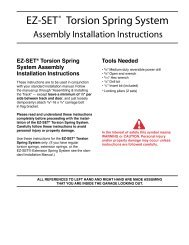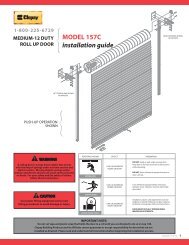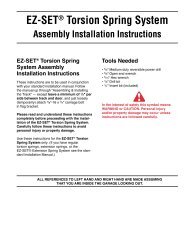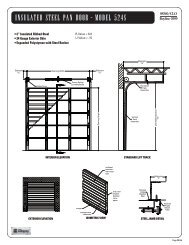The Next Generation Garage Door Installation & Maintenance - Clopay
The Next Generation Garage Door Installation & Maintenance - Clopay
The Next Generation Garage Door Installation & Maintenance - Clopay
You also want an ePaper? Increase the reach of your titles
YUMPU automatically turns print PDFs into web optimized ePapers that Google loves.
THE NEXT GENERATION GARAGE DOOR<br />
INSTALLATION & MAINTENANCE<br />
Steel Residential <strong>Garage</strong> <strong>Door</strong> Instructions<br />
Model: Serial No.:<br />
(Provided on label on interior door surface)<br />
Size: Please complete & mail warranty registration card.<br />
Homeowners Should Retain This Booklet for Future Reference<br />
MISSING ANY PARTS?<br />
PLEASE CALL TOLL FREE: (800-225-6729)<br />
PARTS WILL BE REPLACED PROMPTLY<br />
DO NOT RETURN DOOR TO STORE<br />
(Stores Do Not Carry Spare Parts)<br />
IMPORTANT – Information Needed When Calling:<br />
1) Model number and size of door (Located on packaging)<br />
2) Spring Type (Extension, EZ-Set� Extension, EZ-Set�<br />
Torsion or Standard Torsion)<br />
3) Store city and state of purchase<br />
4) Contract # or serial number if special order<br />
(Located on label on the back of the door or on packaging)<br />
CONSUMER HOTLINE � 1-800-2CLOPAY � 1-800-225-6729<br />
Hours of Operation (ET): Mon. – Fri., 8:30 AM - 7 PM; Sat. 8:30 AM - 5 PM.
This Page Intentionally Left Blank
Introduction and Opening Preparation<br />
STEP 1 – Things to Know Before You Begin ....................................................................................................3<br />
STEP 2 – Read Safety Information ..................................................................................................................4<br />
STEP 3 – Check Headroom, Backroom, Sideroom ..........................................................................................5<br />
STEP 4 – Removing the Existing <strong>Door</strong> Springs ...............................................................................................6<br />
STEP 5 – Removing <strong>Door</strong> Sections and Track .................................................................................................7<br />
STEP 6 – Preparing the Opening .....................................................................................................................7<br />
Preparing the New <strong>Door</strong><br />
Typical <strong>Garage</strong> <strong>Door</strong> <strong>Installation</strong> Illustration .....................................................................................................8<br />
Hardware Components ....................................................................................................................................9<br />
Installing the New <strong>Door</strong><br />
STEP 7 – Preparing Bottom Section ..............................................................................................................10<br />
STEP 8 – Lift Handle Attachment............. ......................................................................................................12<br />
STEP 9 – Installing <strong>Door</strong> Sections.............. ...................................................................................................13<br />
STEP 10 – Reinforcing the Top Section for Opener Attachment ....................................................................14<br />
STEP 11 – Assembling and Installing Track ...................................................................................................15<br />
STEP 12 – Lock <strong>Installation</strong> (if included).................. ......................................................................................17<br />
STEP 13 – Pull Rope.......... ............................................................................................................................17<br />
STEP 14 – Spring <strong>Installation</strong>....... ..................................................................................................................17<br />
STEP 15 – Attaching an Automatic Opener ....................................................................................................18<br />
<strong>Maintenance</strong>/Adjustments/Options<br />
Table of Contents<br />
Painting and Windows ....................................................................................................................................19<br />
<strong>Maintenance</strong> ...................................................................................................................................................20<br />
Checking and Adjusting the <strong>Door</strong> ...................................................................................................................20<br />
Replacement Parts .........................................................................................................................................20<br />
STEP 1 – Things to Know Before You Begin<br />
• Read the instructions completely before starting the installation<br />
of the door. Becoming familiar with the components before<br />
assembling the door will reduce the installation time.<br />
• Be sure all hardware components for your new door are included<br />
before removing existing door (see pages 8,9). If your door is<br />
missing any parts, call the toll-free Consumer Services number<br />
listed on the front of this manual.<br />
• Allow enough time to do the work; removing an existing door will<br />
take approximately 1-3 hours.<br />
• An assistant may be required for lifting the unsprung door. It can<br />
weigh from 100 to 500 pounds.<br />
• A typical installation takes between 9 and 12 hours to complete.<br />
• Keep in mind when planning the installation that the garage<br />
will be open and unsecured when disassembling the old and<br />
assembling the new door.<br />
• If the garage door is the only opening in the structure make sure<br />
everything you need is inside. You will have no way of leaving the<br />
garage until the track is assembled and installed. This will take<br />
approximately 5 hours.<br />
• To avoid damage to the door, you must reinforce the top section<br />
of the door in order to provide a strengthened mounting point for<br />
attachment of an automatic opener (see page 14).<br />
• Low Headroom doors require special instructions. Options for<br />
doors with low headroom can be found on page 5. Purchase<br />
of additional hardware may be required. Check headroom<br />
requirements in the chart on page 5 before beginning.<br />
• To avoid installation problems which could result in personal injury<br />
or property damage, never reuse old track or hardware.<br />
• <strong>Door</strong>s installed in high windload regions (Florida and other high<br />
wind prone areas) may require additional reinforcement beyond<br />
what is detailed in these instructions. Please refer to supplemental<br />
instructions for these areas.<br />
• Express warranties apply only to doors installed using original,<br />
factory-supplied sections, parts, and hardware installed in strict<br />
accordance with these instructions.<br />
Tools Needed<br />
• “C” Clamps or Locking Pliers<br />
• Hammer<br />
• Screwdriver<br />
• Tape Measure<br />
• Level<br />
• Socket wrench kit<br />
• Pliers<br />
• Drill, 1/4", 3/16", & 3/8" drill bits, and 7/16" socket bit<br />
• Step ladder<br />
• Saw horses (with carpet or other soft material on top surface) or<br />
other supports for placing section on while assembling<br />
• Hacksaw<br />
• Wood Saw<br />
• T-Square<br />
• Additional tools may be required; see the Spring Supplement for<br />
more information.<br />
Additional Material Required<br />
• Light household oil<br />
• 1-1/4" x 1-1/4" Minimum punched angle<br />
- 13 ga. (3/32") minimum thickness for Operator Reinforcement<br />
(see page 14)<br />
- 16 ga. (1/16") minimum thickness for rear track hangers on<br />
doors weighing up to 300 lbs. that use torsion springs, or doors<br />
weighing up to 150 lbs. that use extension springs. If your door<br />
exceeds these weight limitations, or if you do not know the weight<br />
of your door, 13 ga. angle should be used. (See page 16)<br />
• Eight 3/8" x 1" bolts and nuts for rear track hangers<br />
• Six 5/16" x 11/2" lag screws for rear track hangers<br />
• Ten 10d 3" nails<br />
• Stop Molding<br />
• Wood Block<br />
• Rope<br />
G01-R01-0704<br />
3
• You can install your new garage door yourself IF…<br />
a) you have help (it may weigh up to 500 lbs.);<br />
b) you have the right tools and reasonable mechanical<br />
aptitude or experience; and<br />
c) you follow these instructions very carefully.<br />
• <strong>Garage</strong> doors use springs to balance them. <strong>The</strong>re are<br />
two types of springs installed — extension or torsion.<br />
Each of these is available in either a standard or EZ-Set TM<br />
assembly option. Please look at the drawings on page 8 to<br />
see which springs your old door has.<br />
• If your old door uses torsion springs, do not attempt<br />
to remove the door or the springs yourself. Have a<br />
qualifi ed door repair service remove them. Attempting to<br />
remove a torsion spring assembly without proper training<br />
or tools may result in an uncontrolled release of spring<br />
forces which can cause serious or fatal injury.<br />
• Only the track specifi ed and supplied with the door<br />
should be used.<br />
• <strong>The</strong> brackets at the bottom corners of your garage door<br />
are under great tension. Do not attempt to loosen any<br />
bracket fasteners except when and as directed in<br />
detail in the following instructions. Otherwise, the<br />
bracket could spring out with dangerous force.<br />
• Do not permit children to play beneath or with any<br />
garage door or electric operating controls.<br />
• In removing a garage door that has extension springs,<br />
follow the instructions carefully, including the use of “C”<br />
clamps or locking pliers on both sides of the door in<br />
order to keep the door from moving once the springs are<br />
removed.<br />
• Keep hands and fi ngers clear of section joints, track, and<br />
other door parts when the door is opening and closing to<br />
avoid injury. <strong>The</strong> lift handles are located for safe operation<br />
as well as easy use.<br />
• Bolts must be installed at the rear end of horizontal tracks.<br />
<strong>The</strong>se act to stop the rollers and keep the door from rolling<br />
off the back of the track.<br />
4<br />
STEP 2 – READ THIS SAFETY INFORMATION<br />
IMPORTANT!<br />
To Protect Yourself From Injury You Must Carefully Read <strong>The</strong> Following Safety<br />
Information and Warnings Before You Install Or Use Your New <strong>Garage</strong> <strong>Door</strong><br />
G01-R01-0704<br />
• Track installations must use sway braces on the rear track<br />
hangers to prevent sideways movement. If the tracks are<br />
not fi rmly stabilized they might spread, allowing the door<br />
to fall and cause severe injury and damage.<br />
• Springs, cables, and bottom fi xtures are under strong<br />
spring tension. Do not attempt to loosen any fasteners<br />
on these components. You could suddenly release<br />
spring forces and risk severe injury.<br />
• If the garage door and/or any of the supporting track<br />
are damaged, operating the door could be hazardous.<br />
Call an authorized representative of the manufacturer or<br />
professional door repair service promptly.<br />
• If repairs are ever required to your door, safety and<br />
trouble-free operation can be best assured by using<br />
original replacement parts.<br />
• Once you have completed the installation of your new<br />
garage door, please be sure that your garage complies<br />
with all applicable ventilation requirements before you<br />
enclose any vehicles in the garage. Good ventilation<br />
avoids fi re and health hazards caused by fumes<br />
accumulating within a well-sealed garage.<br />
• <strong>Clopay</strong> Building Products Company disclaims all liability<br />
for any installation that is not in compliance with applicable<br />
state or county building codes.<br />
• <strong>Door</strong>s equipped with automatic door operators can<br />
cause serious injury or death if not properly adjusted and<br />
operated. To ensure safety of these doors:<br />
a) test the sensitivity of the operator’s safety reverse<br />
mechanism monthly;<br />
b) if your door has a pull down rope, you must remove<br />
the pull down rope;<br />
c) make sure the door remains unlocked;<br />
d) do not allow children to play with the controls.<br />
WARNING<br />
In the interest of safety this symbol means WARNING or<br />
CAUTION. Personal injury and/or property damage may<br />
occur unless instructions are followed carefully.
STEP 3 – Check Headroom/ Backroom/<br />
Sideroom<br />
Headroom is the space needed above the top of the door for<br />
the door, the overhead tracks, and the springs. Measure to<br />
check that there are no obstructions in your garage within that<br />
space. <strong>The</strong> normal headroom space requirement is shown in<br />
Table 3-A. <strong>The</strong> backroom distance is measured from the back<br />
of the door into the garage, and should be at least 18" more<br />
than the height of the garage door. A minimum sideroom of<br />
3-3/4" (5-1/2" for EZ-Set Extension Spring) should be<br />
available on each side of the door on the interior wall surface<br />
to allow for attachment of the vertical track assembly. <strong>The</strong><br />
rough opening should be the same size as the door. (FIG. 3-A)<br />
Track Radius: <strong>The</strong> radius of your track can be determined by<br />
measuring the dimension “R” in FIG. 3-B. If dimension “R”<br />
measures 11" to 12", then you have a 12" radius track. If “R”<br />
equals 14" to 15", then you have a 15" radius track. (FIG. 3-B)<br />
Headroom requirements<br />
<strong>The</strong> standard headroom space requirement is shown in Table<br />
3-A at right. (See page 8 if you have a question on which type<br />
of spring you have.)<br />
Low Headroom? If you have restricted headroom, several<br />
remedies are available. See Table 3-B for various options.<br />
NOTE: <strong>Installation</strong> of the various Low Headroom Options<br />
differs from the installation of a standard headroom door.<br />
Supplemental instructions are included with the hardware of<br />
each Low Headroom Option.<br />
Table 3-B: Low Headroom Options*<br />
Rough Opening = <strong>Door</strong> Size<br />
FIG. 3-A<br />
FIG. 3-B<br />
Backroom = <strong>Door</strong><br />
Height Plus 18"<br />
3-3/4" Minimum Side Room<br />
(5-1/2" Minimum for EZ-Set<br />
Extension Spring)<br />
Table 3-A: Standard Headroom<br />
Requirement Chart<br />
R<br />
G01-R01-0704<br />
Headroom<br />
Required<br />
<strong>Door</strong><br />
Height<br />
Track Headroom<br />
Spring Type Radius Required<br />
EZ-Set Extension Spring or 12" 10"<br />
Extension Spring<br />
EZ-Set Extension Spring or 15" 12"<br />
Extension Spring<br />
EZ-Set Torsion Spring or 12" 12"<br />
Torsion Spring<br />
EZ-Set Torsion Spring or 15" 14"<br />
Torsion Spring<br />
Spring Type Low Headroom Option<br />
Reduces Required<br />
Headroom to: How can I get this option?<br />
Extension and EZ-Set<br />
Extension<br />
Low Headroom Track 4-1/2" Order Low Headroom Track.<br />
Extension and EZ-Set Low Headroom Conversion Kit 4-1/2" Available at most retail stores.<br />
Extension (Modifi es Standard Track)<br />
Extension and EZ-Set<br />
Extension<br />
Quick Turn Bracket 8" on 12" Radius Track Order Quick Turn Bracket Set.<br />
EZ-Set Torsion Low Headroom Track<br />
(Front Mount Spring)<br />
9-1/2" Order Low Headroom Track.<br />
EZ-Set Torsion Low Headroom Conversion Kit<br />
(Modifi es Standard Track)<br />
9-1/2" Available at most retail stores.<br />
Torsion Low Headroom Track 9-1/2" Available from and should be<br />
(Front Mount Spring) installed by professional installer only.<br />
Torsion Low Headroom Track 4-1/2” Available from and should be<br />
(Rear Mount Spring) installed by professional installer only.<br />
*About 3" of additional headroom height at the center plus additional backroom is needed to install an automatic garage door<br />
opener. Check door opener instructions.<br />
5
STEP 4 – Removing the Existing <strong>Door</strong><br />
Springs<br />
<strong>Garage</strong> doors use springs to balance the door weight. <strong>The</strong>re<br />
are two types of springs used — extension and torsion. Each<br />
of these is available in either a standard or EZ-Set TM assembly<br />
option. Please look at the drawings on page 8 to see which<br />
springs your old door has installed. If your present door uses<br />
standard torsion springs, do not attempt to remove the<br />
door or the springs yourself. <strong>The</strong>y should be removed by<br />
a qualifi ed door service professional. Attempting to remove a<br />
torsion spring assembly without proper training and tools may<br />
result in an uncontrolled release of spring forces which can<br />
cause serious or fatal injury.<br />
Extension springs and EZ-Set TM Springs are shown on a<br />
sectional garage door in the illustration on page 8 to see which<br />
springs your door has. <strong>The</strong> following instructions detail how to<br />
remove these springs.<br />
Serious injury could result if spring tension has not been<br />
released before other work begins.<br />
Removing Extension Springs<br />
Use two or more helpers to assist you in lowering<br />
the door.<br />
Step 4-1a: Raise the door to the full open position. Place “C”<br />
clamps or locking pliers tightly on both sides of the track under<br />
the door so the door is held securely in place. With the door<br />
fully open, most spring tension has been removed. (FIG. 4-A)<br />
Do not attempt to remove or adjust extension springs with door<br />
in the down position. Use “C” clamps to keep the door from<br />
moving or falling once the springs are removed.<br />
Step 4-2: Detach the cable at both ends. Disassemble and<br />
remove the springs and cable completely from the door.<br />
NOTE: Wood blocks should be placed underneath the door<br />
when closing to prevent fi ngers from being trapped.<br />
Step 4-3: Remove the “C” clamps from the track and carefully<br />
close the door.<br />
Some large doors might weigh as much as 500 pounds when<br />
the spring tension is removed. <strong>The</strong> weight of the door will not<br />
be apparent when you fi rst begin to close the door. <strong>The</strong> door<br />
will feel progressively heavier as it is lowered until its full weight<br />
(as much as 500 pounds) is realized about one foot from the<br />
fl oor. A single car door may weigh as much as 200 pounds.<br />
(FIG. 4-B)<br />
To avoid injury, keep hands and fi ngers clear of section<br />
joints, track, and other door parts while the door is<br />
opening and closing.<br />
6<br />
WARNING<br />
WARNING<br />
WARNING<br />
WARNING<br />
G01-R01-0704<br />
Removing EZ-Set TM Extension or Torsion<br />
Springs<br />
Step 4-1b: With the door in the DOWN position, position a<br />
drill with a 7/16” socket bit over the worm drive. Using the<br />
reverse (counter-clockwise) direction on the drill, remove all<br />
the tension from the spring (repeat for each side). After spring<br />
tension has been removed, detach the lift cables at both ends.<br />
Disassemble and remove the springs and cable completely<br />
from the door. (FIG. 4-C)<br />
FIG. 4-A<br />
FIG. 4-B<br />
FIG. 4-C<br />
“C” Clamp<br />
Black<br />
Housing<br />
Worm<br />
Drive<br />
Lifting<br />
Cable<br />
Wood<br />
Block<br />
Safety<br />
Cable<br />
Sheave<br />
Red Mark<br />
on Safety<br />
Cable<br />
Sheave<br />
Fork<br />
Black<br />
Bushing
STEP 5 - Removing <strong>Door</strong> Sections & Track<br />
Step 5-1: <strong>The</strong> door can now be disassembled. Starting with<br />
the top section, remove the hardware and unstack the sections<br />
one at a time. (FIG. 5-A)<br />
Step 5-2: After all sections have been removed from the<br />
opening, detach all remaining track and hardware from the<br />
jambs. <strong>The</strong> hangers that attach the rear ends of the overhead<br />
track to the ceiling (called rear track hangers) in many cases<br />
can be reused on the new door if made of 13 gauge (3/32") or<br />
heavier steel and is not loose or unstable. (FIG. 5-B)<br />
To avoid installation problems which could result in<br />
personal injury or property damage, use only the track<br />
specifi ed and supplied with the door. Do not attempt to<br />
reuse old track.<br />
STEP 6 - Preparing the Opening<br />
Step 6-1: On the inside of the garage your opening should<br />
be framed with wood jambs, 2" x 6" if possible. <strong>The</strong> side<br />
jambs should extend to approximately the same height as the<br />
headroom required. If you have just removed an old door, the<br />
jambs should be inspected for the condition of the wood. If the<br />
wood is rotten, it should be replaced now. <strong>The</strong> jambs should<br />
be plumb and the header should be level. If there are any<br />
bolts fastening the jambs to the wall, the heads should be<br />
fl ush so they don’t interfere with the installation of your new<br />
door. (FIG. 6-A)<br />
NOTE: Rough opening (without stop molding) = <strong>Door</strong> size<br />
Step 6-2: <strong>Door</strong> stop molding should be temporarily nailed to<br />
the edges of the jambs fl ush with the inside. (FIG. 6-B)<br />
Stop molding featuring a built-in weather seal is offered as<br />
an option.<br />
FIG. 6-A<br />
WARNING<br />
Opening<br />
Height<br />
3-3/4" Minimum<br />
Side Room (5-1/2"<br />
Minimum for EZ-Set TM<br />
Extension Spring)<br />
Opening<br />
Width<br />
2 x 6<br />
“Header Jamb”<br />
2 x 6<br />
“Side Jamb”<br />
Inside of <strong>Garage</strong><br />
Looking Out<br />
8"<br />
Minimum<br />
Center<br />
Post<br />
(With<br />
Two<br />
<strong>Door</strong>s<br />
Side By<br />
Side)<br />
FIG. 5-A<br />
FIG. 5-B<br />
Inside<br />
FIG. 6-B<br />
Stop<br />
Molding<br />
Rear Track<br />
Hanger<br />
P04-R01-0704<br />
Outside<br />
7
Standard Extension Spring System<br />
Sheave<br />
P04-R01-0704<br />
Stationary Sheave<br />
EZ-Set Extension Spring System<br />
Sheave<br />
EZ-Set Winding Unit<br />
Standard Torsion Spring System<br />
Left (Red)<br />
Cable Drum<br />
End Bearing Plates<br />
Torsion Tube<br />
Red Winding<br />
Cone<br />
Black Winding<br />
Cone<br />
Center Bearing Plate<br />
Stationary<br />
Cone<br />
Right (Black)<br />
Cable Drum<br />
NOTE: <strong>The</strong> above illustration represents a composite of many of the features found on a variety of garage doors. While not<br />
representative of any one door, it provides a handy reference for the location of specifi c components<br />
8<br />
Top Roller<br />
Bracket<br />
#03 Roller<br />
Carrier/Guard<br />
Vertical Track<br />
#02 Roller<br />
Carrier/Guard<br />
#01 Roller<br />
Carrier/Guard<br />
Typical <strong>Garage</strong> <strong>Door</strong> <strong>Installation</strong> Illustration<br />
Extension Spring System Shown on Complete <strong>Door</strong><br />
Safety<br />
Bottom<br />
Bracket<br />
Track Hanger Kit<br />
(Angle Iron)<br />
Not Included<br />
Snap Latch<br />
Horizontal Track<br />
Operator Label<br />
#00 Hinge/Guard<br />
Safety Label<br />
#00 Hinge/Guard<br />
#01 Lock<br />
#00 Hinge/Guard<br />
Containment Cable<br />
Extension Spring<br />
Sheave<br />
Stationary Sheave<br />
#00 Hinge/Guard<br />
Center Stile<br />
#00 Hinge/Guard<br />
End Stile<br />
Lock Cable<br />
#00 Hinge/Guard<br />
Serial Number Label<br />
Safety<br />
Bottom Brackets<br />
Horizontal<br />
Angle<br />
Top Roller<br />
Bracket<br />
Flag Bracket<br />
#03 Roller<br />
Carrier/<br />
Guard<br />
#02 Roller<br />
Carrier/<br />
Guard<br />
#06 Track<br />
Bracket<br />
Striker<br />
Plate<br />
#01 Roller<br />
Carrier/<br />
Guard<br />
#05 Track<br />
Bracket<br />
EZ-Set Torsion Spring System<br />
EZ-Set<br />
Winding Unit<br />
Left Cable Drum<br />
EZ-Set Bracket
Hardware Components<br />
NOTE: All doors will receive (1) spring kit and (1) or more springs. Separate spring installation supplemental<br />
instructions should be included with door hardware. This supplement contains a list of all spring related hardware<br />
along with instructions on proper spring installation.<br />
All doors will receive (2) of these items:<br />
(While not representative of any one model, the quantities below can be used as a guide.<br />
In some instances, extra screws/bolts are provided in the event of strip out or loss of parts.)<br />
DESCRIPTION<br />
Top Roller Bracket<br />
Safe-T-Bracket ®<br />
Bottom Bracket<br />
(1) Pair<br />
#5 Jamb Bracket<br />
#6 Jamb Bracket<br />
#7 Jamb Bracket<br />
(5 Section <strong>Door</strong>s Only)<br />
1/4" X 3/4"<br />
Self Tapping<br />
Screw<br />
1/4"<br />
Flange<br />
Nut<br />
#6 Eyescrew<br />
#14 X 5/8"<br />
Hex Head Sheet<br />
Metal Screw<br />
Roller<br />
2-1/4" Center<br />
Hinge Pin<br />
3" Roller<br />
Carrier Pin<br />
Struts or<br />
L-Angle<br />
DOOR<br />
SIZE*<br />
S<br />
D<br />
S<br />
D<br />
S<br />
D<br />
S<br />
D<br />
S<br />
D<br />
S<br />
D<br />
S<br />
D<br />
S<br />
D<br />
QTY.<br />
0<br />
10<br />
18<br />
24<br />
1<br />
1<br />
56<br />
92<br />
10<br />
10<br />
3<br />
9<br />
6<br />
6<br />
0<br />
1 or 3<br />
DESCRIPTION<br />
#01 Roller Carrier<br />
#02 Roller Carrier<br />
#03 Roller Carrier<br />
#04 Roller Carrier<br />
(5 Section <strong>Door</strong>s<br />
Only)<br />
Horizontal Angle<br />
(1) Pair<br />
#00 Hinge<br />
Lift Handles<br />
Outside/Inside<br />
(1 ea.)<br />
1/4" X 5/8"<br />
Track Bolt<br />
5/16" X 1-5/8"<br />
Lag Screw<br />
Hinge Guard<br />
Fastener<br />
1/4" X 1"<br />
Clevis Pin**<br />
Wire<br />
Cotter Pin**<br />
#12 X 5/8"<br />
Hex Head Sheet<br />
Metal Screw**<br />
*DOOR SIZE: S = Single Car <strong>Door</strong>s (8'-9' W X 7' H), D = Double Car <strong>Door</strong>s (16' W X 7' H)<br />
** Part not standard on all doors<br />
DOOR<br />
SIZE*<br />
S<br />
D<br />
S<br />
D<br />
S<br />
D<br />
S<br />
D<br />
S<br />
D<br />
S<br />
D<br />
S<br />
D<br />
S<br />
D<br />
QTY.<br />
3<br />
9<br />
1<br />
1<br />
18<br />
24<br />
10<br />
10<br />
9<br />
15<br />
1<br />
1<br />
2<br />
2<br />
4<br />
6<br />
DESCRIPTION<br />
P04-R01-0704<br />
3/8" – 16 X 3/4"<br />
Carriage Bolt<br />
Curved<br />
Horizontal Track<br />
Vertical Track<br />
LH & RH Flag<br />
Bracket (1) Pair<br />
3/8"<br />
Flange<br />
Nut<br />
1/4" X 2-1/2"<br />
Clevis Pin**<br />
Operator<br />
Attachment<br />
Bracket**<br />
Supplemental<br />
Operator<br />
Bracket**<br />
Safe-T-Hinge ®<br />
Intermediate<br />
Hinge Guard**<br />
Safe-T-Hinge ®<br />
Roller Carrier<br />
Hinge Guard**<br />
56-1/2"<br />
Horizontal<br />
Brace**<br />
28"<br />
Horizontal<br />
Brace**<br />
Safe-T-Roller ®<br />
Roller Guard**<br />
DOOR<br />
SIZE*<br />
S<br />
D<br />
S<br />
D<br />
S<br />
D<br />
S<br />
D<br />
S<br />
D<br />
S<br />
D<br />
S<br />
D<br />
S<br />
D<br />
QTY.<br />
1<br />
1<br />
1<br />
1<br />
1<br />
1<br />
3<br />
9<br />
6<br />
6<br />
0<br />
2<br />
1 or 2<br />
2<br />
10<br />
10<br />
9
STEP 7 – Preparing Bottom <strong>Door</strong> Section<br />
Step 7-1: Spread the hardware on the garage fl oor in groups<br />
so that you can easily fi nd the new parts. Cover sawhorses<br />
with carpet or cloth to avoid scratching the section.<br />
Step 7-2: Find the section with the weather strip attached to<br />
one edge. This is the bottom section. Place this section face<br />
down on the sawhorses. (FIG. 7-A)<br />
Step 7-3: Select the safety bottom brackets along with (4) #14<br />
x 5/8” sheet metal screws. Bend and break apart the bottom<br />
brackets by hand along the end tabs as shown (FIG. 7-B). Be<br />
sure to remove connecting tabs.<br />
Step 7-4: Insert safety tabs on the bottom bracket into the slots<br />
on the end stile. Make sure the bottom bracket is installed with<br />
the roller carrier on the bottom. Slide the bottom bracket up<br />
to fully engage the tabs (FIG. 7-C). Attach each bracket into<br />
the end stiles with two #14 x 5/8" sheet metal screws. Hook<br />
the looped ends of the steel lift cable over the buttons on the<br />
bottom bracket (FIG. 7-D). If your door came with standard<br />
extension springs, the lift cables are the longer of the two sets<br />
of cable. If your door came with EZ-Set TM Extension Springs,<br />
do NOT attach the lift cables at this time! Do NOT use the<br />
shorter safety containment cables as lift cables, as this will<br />
cause improper door function.<br />
WARNING<br />
Failure to properly engage safety tabs on bottom bracket<br />
into slots on edge of door can result in severe injury when<br />
spring tension is applied.<br />
Step 7-5: Locate the pre-punched hole 3/4” below the top rail<br />
in each stile. Place a roller carrier hinge guard on each end<br />
stile and an intermediate hinge guard on each center stile with<br />
the “ears” in the upward direction as shown. Align the prepunched<br />
hole in each stile with the hole on the hinge guard.<br />
Fasten to the stile using one hinge guard fastener. Push the<br />
fastener into the hole with your fi nger. If the guard rotates<br />
during fastening, adjust to make sure the “ears” are in line with<br />
the stile as shown prior to attaching the roller carrier hinge.<br />
(FIG. 7-E)<br />
Step 7-6: Select the roller carrier with the 01 stamped on it<br />
along with one 3" keyed roller carrier pin. Straddle the end<br />
stile perpendicularly with the roller carrier while aligning the<br />
keyways on the inner leg of the stile just below the top rail.<br />
(FIG. 7-F)<br />
Step 7-7: Insert the 3" roller carrier pin into the roller carrier<br />
and end stile, making sure the key lines line up with the<br />
keyways (FIG. 7-G on page 11). Push the pin through the<br />
stile and hinge hole on the other side until the head of the pin<br />
presses against the inner leg of the hinge. Rotate the roller<br />
carrier clockwise until it lays fl at against the end stile. Twist the<br />
roller carrier pin one half turn counterclockwise.<br />
Repeat Steps 7-6 and 7-7 for the opposite end stile.<br />
10<br />
P04-R01-0704<br />
FIG. 7-A<br />
FIG. 7-B<br />
Bottom<br />
Section<br />
Bottom<br />
Bracket<br />
FIG. 7-C<br />
FIG. 7-D<br />
FIG. 7-E<br />
FIG. 7-F<br />
Slots on<br />
End Stile<br />
Safety Tabs<br />
Slide Direction<br />
Weatherstrip<br />
End Stile<br />
Connecting Tabs<br />
#14 x 5/8" Sheet<br />
Metal Screws<br />
Roller Carrier<br />
Weatherstrip<br />
Straddle<br />
End Stile
Step 7-8: Select the hinge with the 00 stamped on it along<br />
with one 2-1/4" keyed center hinge pin. Straddle the center<br />
stile with the hinge while aligning the keyways on either leg of<br />
the stile. (FIG. 7-H)<br />
Step 7-9: Insert the 2-1/4" center hinge pin into the hinge and<br />
center stile, making sure the key lines line up with the keyways<br />
(FIG. 7-I). Push the pin through the stile and hinge hole on the<br />
other side until the head of the pin presses against the leg of<br />
the hinge. Rotate the hinge clockwise until it lays fl at against<br />
the end stile. Twist the pin one half turn counterclockwise.<br />
Repeat Steps 7-8 and 7-9 for each center stile.<br />
Step 7-10: Refer to Table 7-A to determine if a reinforcing strut<br />
is required on the bottom section. If required, place the strut on<br />
the section below the hinges, positioned about 1/4” from either<br />
end of the section. Attach the strut to the section using two 1/4”<br />
x 3/4” self tapping screws per stile location as shown. When<br />
predrilled holes in strut do not line up vertically with stiles, you<br />
will be required to drill two 3/16” pilot holes through the strut<br />
and the stile at each end stile and each center stile, or use a<br />
drill or impact wrench with a 7/16” socket to drive self tapping<br />
screws through strut and stile. (FIG. 7-J)<br />
Table 7- A - Sections Requiring Struts (<strong>Door</strong>s up to 8'0" high)<br />
<strong>Door</strong> Bottom 2nd 3rd 4th Top<br />
Width Section Section Section Section Section<br />
to 14'10" - - - - -<br />
15'0"–16'0" - - - - ✔*<br />
16'2"–18'0" ✔ - ✔ - ✔<br />
18'2"–20'0" ✔ ✔ ✔ ✔ ✔<br />
*Some doors will receive a reinforcing L-angle in place of a strut.<br />
NOTE: <strong>Door</strong>s installed in regions prone to high wind speeds<br />
may require additional reinforcement beyond what is detailed<br />
in these instructions. Please refer to supplemental instructions<br />
for these doors. (To obtain, call the toll-free Consumer Services<br />
number found on the front page of this manual.)<br />
Step 8 – Lift Handle Attachment<br />
Lift Handle Preparation<br />
Prior to installing, the tabs must be removed from the ends of<br />
the two cylinders protruding from the back of the plastic handle.<br />
Using pliers, twist each tab until it breaks off at the notch mark.<br />
(FIG 8-A)<br />
Bottom Section<br />
Drill two 1/2” holes through the door using the dimple mark and<br />
pre-punched hole on the center stile as a template. If your door<br />
has an outside keyed lock, the hole pattern should be drilled on<br />
the bottom section directly below the lock. If your door does not<br />
have an outside keyed lock, the hole pattern should be drilled<br />
directly below the hinge closest to the horizontal center of the<br />
door. Install the lift handle & inside step plate assembly using<br />
(2) #14 x 5/8” sheet metal screws (Fig. 8-B).<br />
Painting Lift Handles<br />
Plastic lift handles can be painted using a quality spray on or<br />
brushed on enamel paint.<br />
FIG. 7-G<br />
FIG. 7-H<br />
FIG. 7-I<br />
FIG. 7-J<br />
Stile<br />
3" Keyed<br />
Roller Carrier<br />
Pin<br />
2-1/4"<br />
Keyed Center<br />
Hinge Pin<br />
Lift<br />
Handle<br />
Inside<br />
Outside<br />
Lift Handle<br />
FIG. 8-B Inside/Outside Lift Handle Attachment<br />
P04-R01-0704<br />
Lift<br />
Handle<br />
Stems<br />
Straddle<br />
Center Stile<br />
Remove <strong>The</strong>se Tabs<br />
FIG. 8-A<br />
(Bottom Of Lift Handle)<br />
11
Step 9 – Installing <strong>Door</strong> Sections<br />
Step 9-1: Place the bottom section in the opening so that it is<br />
against the stop molding and centered from side to side. Place<br />
a level on the section and use a piece of wood under one end<br />
or the other (if necessary) to make the section level. (FIG. 9-A)<br />
Remove the level and drive a 3” nail into the jambs at each end<br />
and bend it over the edge of the section to hold the section in<br />
place. (FIG. 9-B)<br />
NOTE: <strong>The</strong>se nails are all that will hold the door in place until<br />
all the tracks are secured to the back jambs. Be sure the nails<br />
hold the sections fi rmly in position.<br />
Step 9-2: In general, doors that have windows have them<br />
located in the top section of the door, which does not contain<br />
a Weatherstop ® . If you intend to position your windows in<br />
a section other than the top section, you must remove the<br />
Weatherstop ® from the section you will be using for the top<br />
section, and install it in the window section. Failure to do so<br />
will void your warranty. Locate the Weatherstop ® at the top of<br />
the section and carefully pull it out of the channel at an angle<br />
perpendicular to the top of the section, making sure to keep<br />
it relatively straight. Do NOT “peel” the Weatherstop ® away or<br />
fold or bend it in any way that would create a sharp angle and<br />
cause creasing. Locate the channel on the top of the window<br />
section. Install the Weatherstop ® beginning at the inner wall<br />
of one end stile by applying continuous pressure with your<br />
thumb to snap it into the channel as you move from one end<br />
of the section to the other. To work properly, the seal must be<br />
snapped completely into place. (FIG. 9-C)<br />
Step 9-3: With Table 9-A below, determine the order in which<br />
you will attach the remaining sections.<br />
Table 9-A – Section Order for Various <strong>Door</strong> Heights<br />
<strong>Door</strong> (Bottom) 2nd 3rd 4th Top<br />
Height Section Section Section* Section Section<br />
6'0" 18" 18" 18" 18" -<br />
6'3" 18" 18" 18" 21" -<br />
6'6" 21" 18" 18" 21" -<br />
6'9" 21" 21" 18" 21" -<br />
7'0" 21" 21" 21" 21" -<br />
7'6" 18" 18" 18" 18" 18"<br />
7'9" 18" 18" 18" 18" 21"<br />
8'0" 21" 18" 18" 18" 21"<br />
*Section with general safety label<br />
NOTE: For stacking order for doors greater than 8’0” high, refer<br />
to the Supplemental Instructions for Extended Height <strong>Door</strong>s.<br />
Step 9-4: Place the next section face down on the sawhorses.<br />
If your door is predrilled for a lock, this section will be the<br />
one with the holes in the center of the panel face. Identify the<br />
bottom edge as shown in the illustration (FIG 9-D). Install a 02<br />
roller carrier at each end stile and a 00 hinge at each end stile<br />
following the procedure described in Steps 7-5 through 7-9.<br />
Step 9-5: Keyed Lock <strong>Installation</strong>. If you wish to install a<br />
keyed lock, begin the lock installation now according to the<br />
supplemental instructions included with the lock hardware.<br />
12<br />
P04-R01-0704<br />
FIG. 9-A<br />
FIG. 9-B<br />
FIG. 9-C<br />
Center Stile<br />
FIG. 9-D<br />
Lock Holes<br />
00 Hinge<br />
Stop Molding<br />
Bottom<br />
Edge<br />
02 Roller<br />
Carrier
Step 9 – Installing <strong>Door</strong> Sections<br />
(Continued)<br />
Step 9-6: Refer to Table 7-A on page 11. If a reinforcing strut<br />
is required on this section, refer to Step 7-10 for attachment<br />
instructions.<br />
Step 9-7: Place the second section on top of the fi rst section.<br />
Drive a 3” nail into the jambs at each end and bend it over the<br />
edges of the section to hold the section in place. Attach the<br />
roller carriers and hinges from the top of the fi rst section to the<br />
bottom of the second section using two #14 x 5/8” sheet metal<br />
screws each. (FIG. 9-E)<br />
Step 9-8: From Table 9-A, identify the third section and place<br />
on the sawhorses. Install a 03 roller carrier at each end stile<br />
and a 00 hinge at each end stile following the procedure<br />
described in Steps 7-5 through 7-9.<br />
Step 9-9: Refer to Table 7-A on page 11. If a reinforcing strut<br />
is required on this section, refer to Step 7-10 for attachment<br />
instructions.<br />
Step 9-10: Place the third section on top of the other sections<br />
and nail in place as before. Attach the roller carriers and hinges<br />
from the top of the previous section to the bottom of the third<br />
section. (FIG. 9-E)<br />
NOTE: If you have two sections left, repeat steps 9-8 through<br />
9-10 using 04 roller carriers at the end stiles and a 00 hinge at<br />
each center stile.<br />
Step 9-11: Place the last section on the sawhorses. Attach the<br />
top roller brackets with three #14 x 5/8” sheet metal screws into<br />
the pre-punched holes located approximately 3-1/4” and 6-1/4”<br />
from the top of the section as shown. (FIG. 9-F)<br />
Step 9-12: Refer to Table 7-A on page 11. If a reinforcing strut<br />
or L-angle is required on this section, attach above the top<br />
brackets as shown 1/4” x 3/4” self tapping screws at each stile<br />
location. (FIG. 9-F)<br />
Step 9-13: Place the top section on top of the other sections<br />
and nail in place as before. Attach the roller carriers and<br />
hinges from the top of the previous section to the bottom of this<br />
section. (FIG. 9-E)<br />
NOTE: If your door is to be used with an electric operator, you<br />
must reinforce the top section before placing it in the opening.<br />
Proceed to step 10 prior to completing this step.<br />
Step 9-14: Locate the rollers and roller guards. Align the<br />
fl anges on the roller guard as shown with the shaft of the<br />
roller. Slide the guard onto the roller shaft. Repeat roller guard<br />
assembly for each roller. Place a roller with guard in each top<br />
bracket, bottom bracket, and roller carrier tube. Make sure only<br />
the tapered side of the guard fi ts into the “J” hook or tapered<br />
profi le of the track. (FIG. 9-G)<br />
Roller Carrier Attachment Center Hinge Attachment<br />
FIG. 9-E<br />
L-Angle Attachment<br />
FIG. 9-F<br />
FIG. 9-G<br />
P04-R01-0704<br />
13
Step 10 – Reinforcing the Top Section<br />
For Opener Attachment<br />
14<br />
Cotter Ring<br />
WARNING<br />
To avoid risk of strangulation or personal injury to children,<br />
you must remove the pull down rope when you install an<br />
automatic garage door opener.<br />
IMPORTANT: When installing an automatic garage door opener,<br />
make sure to follow the manufacturer’s installation and safety<br />
instructions carefully. Do not install the pull down rope when<br />
attaching an automatic opener. <strong>The</strong> lock should be removed<br />
or disengaged to prevent damage to the door. If attaching an<br />
operator bracket to the wood anchor pad, make sure the wood<br />
anchor pad is free of cracks and splits and is fi rmly attached to<br />
the wall. Always drill pilot holes before attaching lag screws.<br />
To avoid damage to your door, you must reinforce the top section<br />
in order to provide a mounting point for the opener to be attached.<br />
Refer to the adjacent fi gures to identify the attachment method for<br />
your specifi c door.<br />
NOTE: <strong>The</strong> components depicted on this page are not<br />
provided as standard on all doors.<br />
Odd Number of Stiles with No Strut or L-Angle<br />
FIG. 10A<br />
Odd Number of Stiles with Strut or L-Angle<br />
FIG. 10-B<br />
28" Horizontal Brace<br />
Cotter Ring<br />
P04-R01-0704<br />
#12 x 5 /8" Sheet<br />
Metal Screw<br />
Stile<br />
Operator Bracket<br />
Clevis Pin<br />
Clevis Pin<br />
Operator<br />
Bracket<br />
Center Stile<br />
Even Number of Stiles with No Strut or L-Angle<br />
28" or 56-1/2"<br />
Horizontal Brace<br />
28" or 56-1/2"<br />
Horizontal Brace<br />
1/4"-20 Nut<br />
FIG. 10-C<br />
Cotter Ring<br />
#12 x 5/8" Sheet Metal Screw<br />
1/4"-20 x 5/8"<br />
Hex Head Bolt<br />
Supplemental<br />
Operator<br />
Bracket<br />
Operator Bracket<br />
Even Number of Stiles with Strut or L-Angle<br />
FIG. 10-D<br />
Clevis Pin
STEP 11 – Assembling and Installing<br />
the Track<br />
Before assembling brackets to vertical track be sure to read<br />
Step 11-1 and Step 11-2. Refer to illustration for placement of<br />
brackets on track.<br />
NOTE: Brackets may already be riveted in place. If additional<br />
adjustment is required, the rivets can be drilled out and the<br />
brackets can be reattached with track bolts and fl ange nuts<br />
(available through the toll-free Consumer Services number, see<br />
outside cover).<br />
WARNING<br />
To avoid installation problems that could result in injury or<br />
property damage, use only track provided with new door.<br />
Step 11-1: Loosely fasten the track brackets to the vertical<br />
track using one 1/4" x 5/8" track bolt and 1/4" fl ange nut as<br />
shown with the head of the bolt inside the track. <strong>The</strong>re are<br />
two sizes of brackets for 7’ high doors, and three sizes for 8’<br />
high doors. <strong>The</strong> shortest track brackets should be installed ten<br />
inches from the bottom of the track with the fl ange facing the<br />
fl at side of the track, one on the left and one on the right. <strong>The</strong><br />
next larger sized pair of brackets should be installed centered<br />
on the track. If you have an 8’ high door, the remaining pair<br />
of brackets should be installed ten inches from the top of the<br />
vertical track. <strong>The</strong> fl at side of the track goes toward the wall.<br />
(FIG. 11-A)<br />
Step 11-2: Loosely attach the fl ag bracket to the top of the<br />
track with two 1/4" x 5/8" track bolts and 1/4" fl ange nuts with<br />
the head of the bolts in the track. Make sure bolts and nuts are<br />
attached through the proper holes in fl ag bracket for your door<br />
thickness. (FIG. 11-C)<br />
(Refer to FIG. 11-B to determine proper bolt placement.)<br />
NOTE: If additional adjustment is required, horizontal slots in<br />
fl ag brackets can be used for attachment to vertical track.<br />
Step 11-3: Place the track over the rollers on the door. Move<br />
the track close to the door so that the rollers are all the way<br />
into the hinges. Do not force the track too tightly or the door<br />
will bind. This should leave about 1/2" between the edge of the<br />
door and the track. Pilot holes of 3/16" are required at each<br />
lag screw location before installing the lag screw. Lift track<br />
about 1/2" from the fl oor and fasten the fl ag bracket and track<br />
brackets to the jamb with 5/16" x 1-5/8" lag screws. <strong>The</strong> fl ag<br />
bracket requires three screws, one each in the top, middle, and<br />
bottom holes. Do this for both sides of the door. When the track<br />
brackets and fl ag brackets are securely fastened to the jamb,<br />
tighten the track bolts and fl ange nuts connecting the fl ag<br />
brackets to the tracks. (FIG. 11-D)<br />
NOTE: <strong>The</strong> tops of the vertical tracks must be level with<br />
each other. Check this by measuring from the top of the door<br />
sections to the top of the track on both sides. If they are not<br />
equal, cut some material off the bottom of one track to lower it<br />
or raise the other track.<br />
Do not raise the vertical track beyond the bottom rollers<br />
on the bottom section of door.<br />
NOTE: Do not attach any brackets directly to drywall. All track<br />
brackets, fl ag brackets, and spring brackets should only be<br />
attached directly to wood bucks.<br />
1/4" x 5/8"<br />
Track Bolt<br />
Note: Use One<br />
Track Bolt In Slot.<br />
FIG. 11-A<br />
FIG. 11-B<br />
FIG. 11-C<br />
FIG. 11-D<br />
1/4" Flange<br />
Nut<br />
2" Thick <strong>Door</strong><br />
Use <strong>The</strong>se<br />
Two Holes<br />
1/4" Flange<br />
Nut<br />
1/4" x 5/8"<br />
Track Bolt<br />
Bottom<br />
Shorter<br />
Track<br />
Bracket<br />
G01-R01-0704<br />
Wall<br />
Side<br />
Top View<br />
Left Side<br />
1-3/8" & 1-1/2"<br />
Thick <strong>Door</strong><br />
Use <strong>The</strong>se<br />
Two Holes<br />
Flag Bracket<br />
Flag Bracket<br />
Left Hand<br />
Vertical Track<br />
Assembly<br />
Top<br />
Right Hand<br />
Vertical<br />
Track<br />
Longer Assembly<br />
Track<br />
Bracket<br />
Finished Track Assembly<br />
15
STEP 11 - Assembling and Installing the<br />
Track (Continued)<br />
NOTE: Pressure-treated lumber purchased after January 2004<br />
is treated with chemicals that have highly corrosive effects on<br />
metal fasteners. <strong>The</strong> fasteners provided with your door are<br />
intended for use with standard lumber (not pressure-treated)<br />
only. If you are installing your door into an opening framed with<br />
pressure-treated lumber, it is highly recommended that 5/16” x<br />
1-5/8” lag screws with a minimum galvanization equivalent of<br />
G185 be purchased for this application.<br />
Step 11- 4: Fasten the horizontal angle to the horizontal<br />
(curved) track with two 1/4" x 5/8" track bolts and 1/4" fl ange<br />
nuts so that the heads of the track bolts are on the inside of<br />
the track. On some doors this angle may be 82" long and will<br />
require three additional fasteners per side. If the angle has<br />
been preassembled, skip Step 11-4 and proceed with<br />
Step 11-5. (FIG. 11-E)<br />
Step 11-5: Temporarily support the rear end of the track with<br />
a rope from the trusses overhead in the garage or on a tall<br />
ladder. (FIG. 11-F)<br />
Step 11-6: Place the track over the roller in the top bracket.<br />
Attach the curved end of the horizontal track to the fl ag<br />
bracket with two 1/4" x 5/8" track bolts and 1/4" fl ange nuts<br />
so that the heads of the screws are on the inside of the track.<br />
<strong>The</strong> horizontal and vertical track must join together to form<br />
a continuous channel for the rollers. Attach the end of the<br />
horizontal angle to the top of the fl ag bracket with a 3/8” x 3/4”<br />
carriage bolt and 3/8” hex nut. Use the top set of slots for 15”<br />
radius track, the middle set of slots for 12” radius track, and the<br />
bottom set of slots for Low Headroom track. (FIG. 11-G)<br />
Step 11-7: Rear track hangers need to be made at this time.<br />
Use 1-1/4" x 1-1/4" punched angle, 13 gauge or 3/32" steel.<br />
<strong>The</strong>se are not provided with the standard hardware. <strong>The</strong>y<br />
are used to attach the rear of the horizontal track to the<br />
ceiling joist.<br />
Enough angle iron or punched angle should be purchased to<br />
make two rear track hangers. <strong>The</strong>se hangers must be strong<br />
enough to hold the full weight of the door. Attach a bolt at least<br />
1" long through the end of each track to stop the door at the<br />
end of its travel. (FIG. 11-H)<br />
WARNING<br />
Sway braces must be used to prevent tracks from<br />
spreading and allowing door to fall, which could cause<br />
serious injury. Bolts placed in the end of each track<br />
(FIG. 11-H) must be at least 1" long to prevent the top<br />
section from exiting the track.<br />
NOTE: Rear track hangers should not be mounted any farther<br />
than 6" from the end of horizontal track.<br />
Step 11- 8: Placement of rear track hangers is critical for the<br />
door to operate properly. <strong>The</strong> rear track hangers should hold<br />
the horizontal track level and square to the door. Squareness<br />
should be measured by comparing two diagonal distances: 1)<br />
the distance from the top left-hand corner of the door to the<br />
rear of the right-hand horizontal track and 2) the distance from<br />
the top right-hand corner of the door to the rear of the left-hand<br />
horizontal track. (FIG. 11-I, opposite page)<br />
16<br />
G01-R01-0704<br />
FIG. 11-E<br />
Flag Bracket<br />
FIG. 11-F<br />
3/8" x 3/4"<br />
Carriage<br />
Bolt<br />
FIG. 11-G<br />
3/8" x 1"<br />
Bolts & Nuts<br />
(4 places)<br />
FIG. 11-H<br />
Horizontal Track<br />
Horizontal Angle Bracket<br />
Horizontal<br />
Track<br />
Vertical<br />
Track<br />
Horizontal Angle<br />
Horizontal<br />
Angle<br />
Rope<br />
Horizontal<br />
Track<br />
Sway Brace<br />
Bolt Blocks<br />
<strong>Door</strong> Travel
Step 11- 8, Continued: Adjust the position of the tracks if<br />
the squareness distances are not within 1/2" of each other.<br />
Horizontal track can be out of level up to 1" from front jamb to<br />
rear track hanger. (FIG. 11-I)<br />
When the track is square and level with the opening, the track<br />
hangers can be fastened permanently to the ceiling trusses.<br />
Three 5/16" x 1-1/2" lag screws are recommended. Be sure<br />
3/16" pilot holes are drilled before installing 5/16" lag screws.<br />
<strong>The</strong> attachment must be strong enough to hold the weight of<br />
the door.<br />
Use adequate length screws to fasten rear track hangers<br />
into trusses. <strong>Door</strong> may fall and cause serious injury if not<br />
properly secured.<br />
Step 11- 9: With the track installed, the top door section can<br />
now be properly adjusted. With the slide on the top bracket<br />
loose, force the top of the door against the stop molding or<br />
door jamb. Pull the roller towards you so it is tight against the<br />
groove in the track and tighten the slide bolts. (FIG. 11-J)<br />
At this time, remove the 3" nails that were used to hold<br />
sections in place prior to installation of the track assembly.<br />
(Refer back to FIG. 9-B.)<br />
STEP 12 – Lock <strong>Installation</strong> (If Included)<br />
Keyed Lock:<br />
If your door has an exterior keyed lock, please complete the<br />
installation of the lock at this time following the instructions<br />
provided with your lock hardware. If your door has a slide bolt<br />
lock, install according to the instructions below.<br />
Slide Bolt:<br />
WARNING<br />
<strong>The</strong> inside slide bolt is installed on the end stile of the second<br />
section using (4) #14 x 5/8" hex head sheet metal screws (steel<br />
doors) or (4) 1/4" x 1" lag screws (wood doors). (FIG. 12-A)<br />
NOTE: 3/16" holes may have to be predrilled before installing<br />
screws.<br />
<strong>The</strong> slide bolt rests against the top of one of the rectangular<br />
engaging slots in the vertical track. Proper alignment is easier<br />
to achieve by using track as a guide.<br />
NOTE: It may be necessary to knock out the slug in the vertical<br />
track to open the slot for lock engagement. Remove slug by<br />
striking with a hammer from the outside of the track.<br />
IMPORTANT: If your door is going to be equipped with an<br />
automatic garage door opener, make sure that the door is<br />
always unlocked when the opener is being used. This will<br />
avoid damage to the door.<br />
STEP 13 – Pull Rope (Manually Operated<br />
<strong>Door</strong>s Only)<br />
To complete the door section installation, tie the pull rope<br />
provided to the bottom roller shaft. (FIG. 13-A)<br />
STEP 14 – Spring <strong>Installation</strong><br />
It is now time to install the spring. Proceed to springing<br />
instructions that came with your spring hardware.<br />
FIG. 11-I<br />
Top Roller<br />
Bracket<br />
FIG. 11-J<br />
FIG. 12-A<br />
FIG. 13-A<br />
Pull Rope<br />
G01-R01-0704<br />
Slide<br />
Bolts<br />
Slide<br />
#14 x 5/8" Sheet Metal Screw or 1/4" x 1" Lag Screw<br />
17
STEP 15 – Attaching an Automatic Opener<br />
IMPORTANT: To avoid damage to your door, you must<br />
reinforce the top section of the door in order to provide a<br />
mounting point for the opener to be attached. Refer to the<br />
section of this manual titled Reinforcing the Top Section on<br />
page 14 for specifi c instructions. Failure to reinforce the door<br />
as illustrated will void the warranty on your door.<br />
WARNING<br />
To avoid risk of strangulation or personal injury to<br />
children, if your door has a pull rope, you must remove<br />
the pull down rope when you install an automatic garage<br />
door opener.<br />
IMPORTANT: When installing an automatic garage door<br />
operator, make sure to follow manufacturer’s installation and<br />
safety instructions carefully. Remove the pull down rope and<br />
unlock or remove the lock. If attaching an operator bracket<br />
to the wooden anchor pad, make sure the wood anchor pad<br />
is free of cracks and splits and is fi rmly attached to the wall.<br />
Always drill pilot holes before attaching lag screws.<br />
<strong>The</strong> operator arm will usually be attached to the vertical<br />
reinforcement member at roughly the same height as the top<br />
roller of the door. Attach the opener arm to the reinforcement<br />
as shown in Figures 15-B to 15-D. To prevent the top of the<br />
door from bending, the opener rail should be mounted no less<br />
than 2" and no greater than 5" from the face of the door with<br />
the door in the open position (FIG. 15-A). Additionally, when<br />
the door is closed, the portion of the operator arm attached to<br />
the door should be at angle of approximately 60 degrees from<br />
the vertical (FIG. 15-B).<br />
18<br />
Opener Arm Attachment To Horizontal Angle Or Strut<br />
Punched<br />
Angle<br />
Punched<br />
Angle<br />
Horizontal<br />
Angle<br />
Or Strut<br />
Opener Arm<br />
Horizontal Angle<br />
Or Strut<br />
Front View (Assembled)<br />
G01-R01-0704<br />
Supplemental<br />
Bracket (Not Available<br />
On All <strong>Door</strong>s)<br />
Opener Arm<br />
Lock <strong>The</strong>se Nuts<br />
Together Securely<br />
FIG. 15-C (<strong>Door</strong>s with odd number of Panels)<br />
Opener Rail Mounting Distance<br />
FIG. 15-A<br />
3/8" x<br />
1-1/2"<br />
Hex Bolt<br />
Opener Arm<br />
Top View<br />
(assembled)<br />
Leave<br />
Clearance<br />
Clevis<br />
Pin<br />
Opener<br />
Arm<br />
Ceiling<br />
Opener Rail<br />
Horizontal Track<br />
Keep Clearance at 2"–5"<br />
60°<br />
FIG. 15-B (<strong>Door</strong>s with supplied Reinforcement Bracket<br />
and Stile in Center of <strong>Door</strong>)<br />
Opener Arm Attachment To Vertical Angle<br />
Horizontal<br />
Punched<br />
Angle<br />
Vertical<br />
Punched<br />
Angle<br />
Mounting<br />
Surface Of<br />
<strong>Door</strong><br />
Vertical Punched<br />
Angle<br />
Lock <strong>The</strong>se<br />
Nuts Together<br />
Securely<br />
FIG. 15-D (<strong>Door</strong>s with Angle Iron Reinforcement<br />
Bracket and Stile in Center of <strong>Door</strong>)<br />
3/8"<br />
Hex Nut
Painting your <strong>Door</strong><br />
Paint: Your steel garage door can be painted with a high quality,<br />
100% acrylic latex (flat, satin, or semi-gloss) exterior grade paint.<br />
oil-based<br />
NOTE: Do not use oil-based paint. Using oil-based paint will<br />
void the warranty on your door.<br />
Cleaning: Before painting your door, it must be free of dirt, oils,<br />
chalk, waxes and mildew. <strong>The</strong> prepainted surfaces can be<br />
cleaned of dirt, oils, chalk and mildew with a diluted solution of<br />
trisodium phosphate. Trisodium phosphate is available over the<br />
counter at most stores under the name SOILAX®, in many<br />
laundry detergents without fabric softener additives, and in some<br />
general purpose cleaners. Check the label for trisodium<br />
phosphate content. <strong>The</strong> recommended concentration is 1/3 cup<br />
of powder to 1–1/2 to 2 gallons of water. After washing the door,<br />
always rinse well with clear water and allow to dry.<br />
If the door has ever been waxed, the wax must be removed<br />
before painting. <strong>Door</strong>s are not waxed during the manufacturing<br />
process. <strong>The</strong> wax can be removed by wiping door surface with a<br />
rag saturated with Xylene (Xylol), available at most paint or<br />
hardware stores. Wiping should be done at moderate pressure<br />
and Xylene must not be allowed to sit on the door for an<br />
extended time. Damage to your door’s paint system can occur if<br />
overexposed to this or other solvents.<br />
Caution: Safety instructions on the solvent’s container must be<br />
followed. After de-waxing the door, clean with trisodium<br />
phosphate, as stated previously.<br />
NOTE: Sanding could remove rust-inhibiting compounds,<br />
therefore, sanding should be done only to damaged areas where<br />
bare metal has been exposed. Refer to the “Paint Repair”<br />
section of these instructions.<br />
Paint Repair: Should your door’s paint finish become damaged,<br />
exposing the bare metal, it will become necessary to repair this<br />
area to prevent rust from forming. <strong>The</strong> damaged area should be<br />
lightly sanded with a medium to fine sandpaper making sure to<br />
remove all visible red and white rust. Wipe this area with a dry,<br />
clean rag. Coat the sanded area with a high quality, rust<br />
inhibiting, zinc enriched primer. This type of primer can be found<br />
at most paint or hardware stores, and should be labeled for<br />
covering bare and galvanized steel. Once the primer is applied,<br />
wait the time specified on the primer’s instructions before you<br />
finish painting your door.<br />
Paint: Your steel garage door can be painted with a high quality,<br />
100% acrylic latex (flat, satin, or semigloss) exterior grade paint.<br />
Since all paints are not created equal, the following test needs to<br />
be performed: paint should be applied on a small area of the<br />
door (following the instructions on the paint container), allowed to<br />
dry, and evaluated prior to painting the entire door. Paint defects<br />
to look for are blistering and peeling. An additional test is to<br />
apply a strip of masking tape over the painted area and peel<br />
back, checking to see that the paint adheres to the door and not<br />
to the tape.<br />
After satisfactorily testing a paint, follow the directions on the<br />
container and apply to the door. Be sure to allow adequate<br />
drying time should you wish to apply a second coat.<br />
Window frames & inserts can be painted with a high quality,<br />
100% acrylic latex. <strong>The</strong> plastic should first be lightly sanded to<br />
remove any surface gloss.<br />
NOTE: Do not apply paint when door surface temperature is<br />
different from manufacturer’s suggested temperature range for<br />
application.<br />
Caution: he section joints of this garage door have been<br />
designed to operate at precise tolerances. Do not paint the<br />
joints of the sections as difficulty in operation may result that<br />
will not be covered by the limited warranty.<br />
Snap-In Decorative Insert Removal And<br />
Replacement:<br />
NOTE: DO NOT REMOVE SCREWS from the window frame.<br />
Decorative inserts are designed to snap-in and out of the window<br />
frame.<br />
Some doors with windows have a decorative insert attached<br />
behind the window. <strong>The</strong>y may be moved to the outside of the<br />
glass, or can be removed for cleaning or painting purposes.<br />
1) Remove the four tabs of the insert from under the edge of the<br />
inside window frame. <strong>The</strong>re is one tab on each side and one<br />
on the top and bottom of the insert.<br />
2) <strong>The</strong> insert can be firmly pulled out of the window.<br />
3) Replacing the insert is the reversal of the process described<br />
for removal. <strong>The</strong> four tabs must be pressed under the lip in<br />
the window frame.<br />
4) If preferred, the insert can be snapped into the frame on the<br />
outside of the glass.<br />
Glass Replacement<br />
�������<br />
To avoid injury, use extreme caution in handling glass window<br />
pane. When the frame is removed, the exposed steel edge of the<br />
door may be sharp. Avoid contact with the steel edges.<br />
Glass Replacement: If your door is equipped with windows and<br />
the glass should need replacement, follow the steps below:<br />
1) With someone holding the outside frame, remove the screws<br />
from the inside window frame.<br />
2) Pull the inside frame out of the door.<br />
3) Carefully remove the broken or old glass.<br />
4) Insert the new glass. <strong>The</strong> glass should be 11” by 18-1/2”<br />
(standard panel windows) or 11” x 40-1/4” (long panel<br />
windows).<br />
5) With someone holding the outside frame, reinsert the screws<br />
into the inside frame, trapping the glass.
������������������<br />
���� ������������������������������������������������������������<br />
���������������<br />
���� ����������������������������������������<br />
���� ����������������������<br />
���� ������������������������������������������<br />
���� ���������������������������������������������������������<br />
�����<br />
���� ���������������������������������������������������������<br />
���� �������������������������������<br />
���� ���������������������<br />
���� ����������������������������������<br />
������������������������������������������������������<br />
���������������������������������������������<br />
�����������������������������������������������������������<br />
�����������<br />
�������������������������������������������������������<br />
���������������������������������������������������������������<br />
���������������������������������������������<br />
���� ���������������������������������������������������������<br />
��������<br />
���� �������������������������������������������������������<br />
���������������������������������������������������<br />
���� ���������������������������������������������������������<br />
�������������������������������������������������������<br />
���������������<br />
���� ��������������������������������������������������<br />
��������������������<br />
���� ������������������������������������������������������<br />
��������������������������������������������������������<br />
�����������������������������������������������������<br />
����������������������������������������������������������<br />
��������������������������������������������������������<br />
��������������������������������������������������������<br />
�������������<br />
���� ����������������������������������������������������������<br />
���������������������������������������������������������<br />
�����������������������������<br />
��<br />
������������������<br />
��������������������������������������������������������������<br />
����������������������������������������������������������<br />
��������������������������������������������������������������<br />
����������������������������������������������������<br />
������������������������������������������������������������������<br />
���������������������������������������������������������<br />
������������������������<br />
������������������������������������������������������������<br />
�������������<br />
�����������������<br />
���������������������������������<br />
������������������������������������������������������������<br />
������������������������������������������������������������������<br />
������������������������������������������������������������<br />
�������������������������������������������������������������<br />
�����������������������������������������������������������<br />
�������������������������������������������<br />
Glass, �����������������������������������������<br />
Plexiglass, Stained Look, Leaded<br />
Look, Brilliance, and Studio Series Windows<br />
�������������������������������������<br />
Cleaning and Care Instructions<br />
�������������������������������������<br />
Clean with a mild solution of a dishwashing detergent<br />
and ������������������������������������������������������<br />
a soft cloth. After cleaning, rinse thoroughly. DO<br />
NOT �����������������������������������������������������������������<br />
use any ammoniated, abrasive, or solvent-based<br />
cleaners of any kind.<br />
��������������������������������������������������������<br />
Studio ����� Series Windows Only:<br />
Use a good grade of automotive paste wax and buff with a<br />
soft �������������������������������������������������������������<br />
cloth. Windows should be cleaned and waxed at least<br />
once ������������������������������������������������������������<br />
annually or more often based on the atmospheric<br />
conditions �����������������������������������������������������������<br />
where installed.<br />
����������������<br />
Caution: Use care when handling decorative windows to<br />
avoid �����������������������������������<br />
scraping or scratching the surface.<br />
NOTE: �����������������������������������������������������������<br />
Minor scratches or scuffs are not considered<br />
defects ��������������������������������������������������<br />
and will not be cover under the window warranty.<br />
�����������������<br />
���������������������������������������������������<br />
�����������������������������������������������������������������<br />
�������������������������������������������������������������<br />
��������������������������������������������������������<br />
�������������������������������������������������������������<br />
��������������������������������������������������<br />
������������������������<br />
�����������������������<br />
��������������<br />
����������������������<br />
������������������������������<br />
������������������������<br />
�������������������������������<br />
������������������������<br />
��������������������������������������� ���������41



